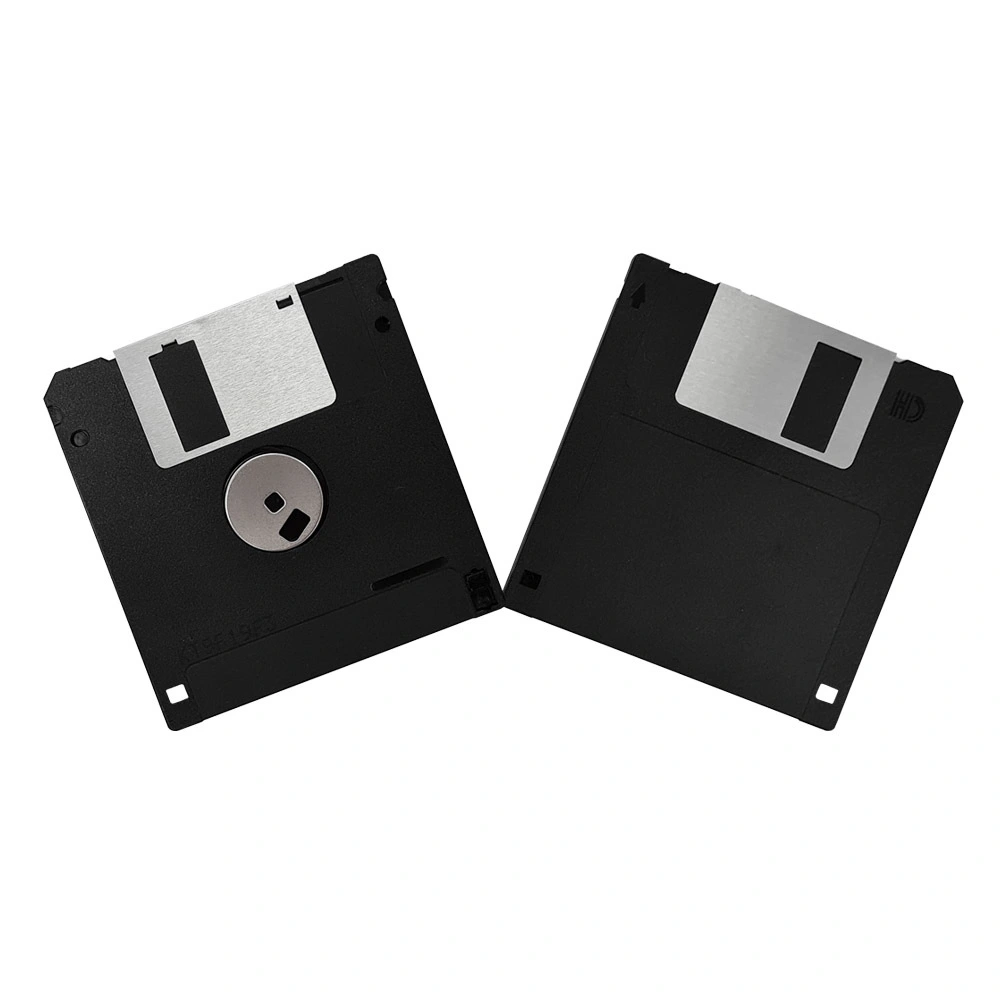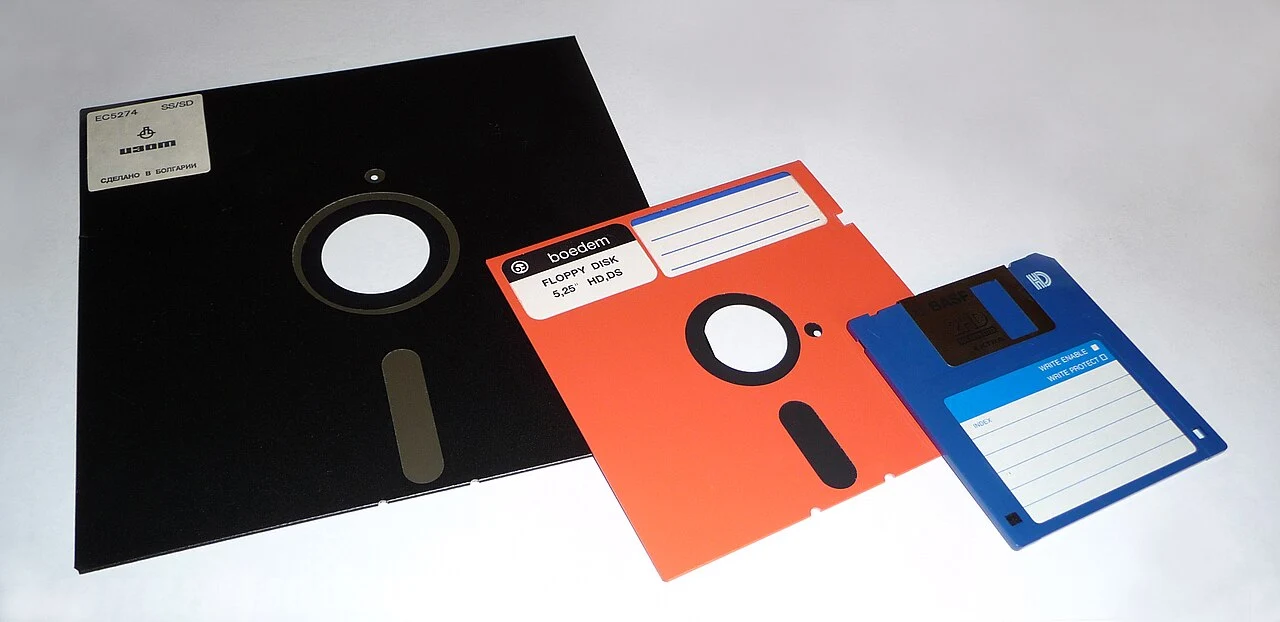I found this old software on a medium I don’t recognize at my church. Does anyone know if this has value to anybody?
 this
this
It’s the guts of 3.5" floppies, like these, they usually stored 720kB, then 1.44MB, but the latest versions (double sided) were 2.88MB.

The larger one at the bottom is from a 5 1/4" (orange in this picture, the big daddy in the picture is 8", first type I used, with COBOL)

… and now you kids know where the “save” button icon came from.
They were not meant to be removed from their protective envelopes, they’re probably damaged now.
God damn I’m old.
This reminds me of when I got a new PC when I was younger and I was shocked… “WHAT?! THEY COME WITH 128MB RAM NOW!!! AND THEY HAVE A DVD TRAY??? No more floppy disks!!!”
Fuck, those were nice times (except for dial-up internet).
I remember having a CD burner, dvd burner, floppy drive, and Zip drive for those rare occasions.
I remember backing up all my documents on a zip drive and feeling like we reached peak storage.
Last month I bought two 6TB drives into my house because of all my photos/videos.
I still have a working zip drive.
Felt like we could store the whole world on 100mb zip disks
Zip drives!
I still have a bunch of zip disks that I want to examine. Think they’re still good?
I got all excited when the cost of hard drives got down to $10/MB.
Started with the 8" bastards on a dedicated word processor (with a 12" CRT, green phospher glow, and typwriter style printer built right into the top of the unit!) that my dad had for medical filekeeping at his office.
It’s been amazing watching storage tech from those to zip drives, and now, floppies of any kind are dying.
My daughter found a 3.5" floppy in a drawer a couple of years ago (she was 20) and went “What is this? It looks just like a ‘Save’ button!” :)
I hope you smacked her for that lol.
My parents first computer was 3 feet tall and cost $30,000. I liked to play frogger on it lmao.
First game I ever played was on those 8” floppies. It was a turtle game where you would type in DOS commands and make it move. I can’t remember the command prompts but it was fun enter like forward 1000 and it would blast across the screen.
That’s it! Ha ha wow haven’t seen that since elementary school.
Logo wasn’t a game but a programming language.
As far as I can remember, it was both, as it was an educational tool developed to teach children the basics of programming while playing it as a game.
I learned this and BASIC at around the same time.
That sounds like Logo
I remember that! As others have posted, Logo.
Don’t forget the cassettes before that. (Sinclair 1000 / ZX-81)
Oregon Trail, on cassette, on a RadioShack TRS-80 in the school library.
Gaming heaven.
If you play them backwards a satanic message is heard before the media bursts into flames.
https://en.m.wikipedia.org/wiki/Beagle_Bros
The box is from some fancy Apple software from long before most of you were born.
The contents are just the skeletal remains of assorted species of the Save Icon.
Interesting they look like three and a half inch floppies out of their sleeves
That’s definitely what it is, but why was it removed from the plastic housing? It would never last long without the protection, and even if it was being bulk-written to, you wouldn’t do it outside the housing.
Very strange.
I would rip em up as a kid all the time.
The more interesting thing to me is the oddly old timey brand
That brand was a software maker back in the Apple II days.
Nobody ever asks why it’s the C:\
Pour one out for A:\ and B:\
That looks like a floppy disk with the protective casing removed…
Hope this is just a Boomer hating shit post. Pretty sure it is.
12 megabytes of RAM, 500 megabyte hard drive, built-in spreadhseet capabilities and a modem that transmits it over 28,000 bps
deleted by creator
Well, I feel old.
3.5” floppy discs which have been removed from their plastic shells.
Yeah, as others have said, floppies without cases.
Just to be clear, floppy cases were never meant to be removed. They were glued together in such a way that it wasn’t possible to take the case off without breaking the case. And these disks can’t be read without the cases. Basically, the cases were considered part of the disk (just like the plastic casing of a an audio cassette or VHS is integral to the functioning of the medium.) I have to imagine whoever took these out of their cases had a misunderstanding about how computers on the order of thinking a CD-ROM tray is a drink holder or trying to print a document by laying the monitor face-down on the bed of a copy machine.
If you wanted to read the 3.5" disks, you might be able to do so if you can procure a proper floppy drive and some sacrificial floppy disks. It’d probably take some finesse and careful gluing skills.
But that all assumes that these disks haven’t lost their data already. Floppies tend to just plain old degrade over time. So the data very is very likely heavily corrupted.
I have heard of really specialized hardware to read data off of degraded disks, but that’s probably “you have to know a guy/gal” level of specialization. If you really wanted to go that route, I think you’d probably want to know if what you have there is “valuable” (basically not already available on Archive.org and also interesting like unreleased source code or something.) But if you thought you had something like that and wanted to pursue it, you could @ Jason Scott (@textfiles@mastodon.archive.org) on Mastodon. If anybody has a lead on how to read those, it’s him.
One more interesting feature was the “write lock” switch on the 3.5" ones, a sliding button that covered one of the squared holes on their edges. The floppy drive would sense that and refuse to write on them.
On the 5.25" it was a notch cut on the side (there were punchers for that). To write on a “protected” disk, you’d cover the notch with adhesive tape.
They were probably disassembled for showcase. They weren’t the most resilient of things and eventually enough area of the disk would degrade as to make the disk unusable. Eventually as in, really fast. Every office had a pile of defective floppies marked as corrupted to prevent people from losing their data to them. Essentially you could format and write on them but reading was impossible or returned garbled data. They were comonly disassembled to showcase how they worked and to experiment as they were a cheap source of ferromagnetic coated cellulose.
They can probably be read if you thrown them into another case. I used to rip them apart and put them back together as a kid.
the disk that lies inside a floppy disk (a 5.25 floppy disk judging by the size)
Looks like the physical storage medium of a 3 1/2 inch diskette. Which is usually called a 3 1/2 inch floppy disk, except with this one it’s a bit of a misnomer, since this iteration has a rigid case, unlike the older 8 inch and 5 1/4 inch versions. Or should have, it appears to be removed in OP’s case.
The disk itself is flexible, hence the floppy disk. In contrast a hard disk had rigid platters, hence hard. The outer casing has nothing to do with it.
You’re technically correct, the best kind of correct. And that said, from a daily-use perspective, the 3½" type has a rigid case, i.e. not floppy. So the storage medium is floppy, while the whole object that the user is expected & supposed to interact with is not. That’s why I find “3½ inch floppy disk” to be a bit of a misnomer.
The 8" and 5¼" types have soft carriers, which is why I have no qualms calling those “floppy disks.”
Wow this makes me feel old
Thanks, everyone. I thought that’s what they were, but thought there was maybe something I didn’t know. I think we’ll probably just trash them.
From Beagle Bros - Wikipedia:
Beagle Bros was an American software company that specialized in creating personal computing products. Their primary focus was on the Apple II family of computers. Although they ceased business in 1991, owner Mark Simonsen permitted the Beagle Bros name and logo to be included on the 30th anniversary reboot of I. O. Silver, released on December 12, 2014 by former Beagle programmer Randy Brandt.
Found via reverse image search:
Copy A: . B:\
floppy disk days long and gone










